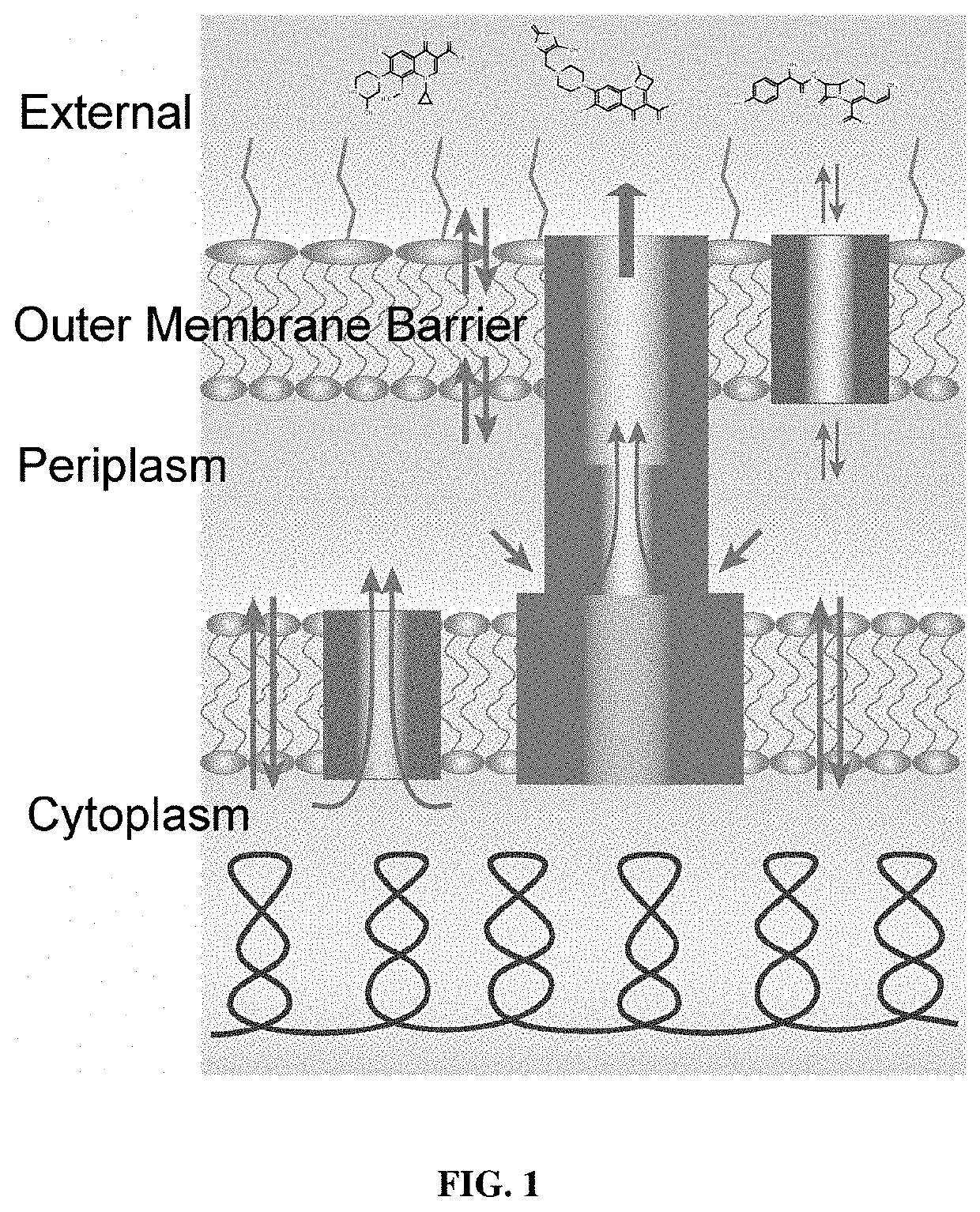Fluorescent probes for drug permeability in gram negative bacteria
a technology of gram negative bacteria and fluorescent probes, which is applied in the field of microbiology, medicine and membrane biology, can solve the problems of presenting a major challenge to the treatment of infectious diseases, rendering antibiotics ineffective, etc., and achieves the effect of enhanced fluorescen
- Summary
- Abstract
- Description
- Claims
- Application Information
AI Technical Summary
Benefits of technology
Problems solved by technology
Method used
Image
Examples
example 1
[0207]Experiments were carried out in four E. coli strains, BW25113, a wild type strain with efflux pumps, ΔEfflux, a cell line in which the efflux pumps have been inactivated by removal of tolC gene and their hyperporinated variants WT-Pore and ΔEfflux-Pore. Four compounds were tested in these cell lines which show increased fluorescence intensity in cells in which the efflux pumps have been removed (FIG. 3). Finally, the emission spectra was collected for each of these compounds which show that in the presence of cells, the compounds fluorescence while without cells, the compounds show little to no background fluorescence. See FIG. 3.
example 2
[0208]General Synthetic Procedures.
[0209]Compounds of the present invention can be categorized into two basic structural classes, dihydroimidazolines (I) and diaminoquinolines (II) and were prepared as summarized below. Compounds belonging to type (I) were synthesized from 4-(4,5-dihydro-1H-imidazol-2-yl)aniline (3). Aniline 3 was prepared from 4-aminobenzonitrile using the outlined literature procedure (Sun et al, 2008). The bis-substituted imidazoline 5 was prepared in an analogous manner. Coupling of either 3 or 5 with the requisite acid chlorides in acetic acid (Hagmann, 1998) following the known procedure gave rise to dihydroimidazolines of type (I).
[0210]The quinolone structures of type (II) were prepared from coupling of 3-methylquinoline-4,7-diamine (8) with various acid chlorides in acetic acid. Quinoline 8 was prepared in two steps from acetone and 2-amino-5-nitrobenzonitrile (6). Condensation of 6 with acetone gave rise to the nitro-quinolone 7. Reduction of the nitro gro...
example 3
Experimental Details
Synthesis of 3,4-bis(4,5-dihydro-1H-imidazol-2-yl)aniline 3-TFA (5)
[0211]
[0212]4-aminophthalonitrile (358 mg, 2.5 mmol) was added to a reaction vial along with sodium hydrosulfide hydrate (608 mg, 10 mmol). Dimethylacetamide (1.0 mL) was added before ethylenediamine (3.34 mL, 50 mmol) and the reaction was heated at 110° C. for 12 hours. Solvent was removed and crude product was purified on a 50 g C18 reversed-phase column (acetonitrile / water w / 0.05% TFA). Product was isolated as a 3-TFA salt (712 mg, 50% yield).
Synthesis of N-(4-(4,5-dihydro-1H-imidazol-2-yl)phenyl)cinnamamide
[0213]
[0214]4-(4,5-dihydro-1H-imidazol-2-yl)aniline (0.3 mmol) was dissolved in 1.5 mL glacial acetic acid and stirred at rt for 5 min. To this mixture was added cinnamoyl chloride (0.36 mmol). The resulting mix was sonicated to mix before being allowed to react overnight at room temperature. The solvent was removed and crude product was purified on a 50 g C18 reversed-phase column (acetonit...
PUM
| Property | Measurement | Unit |
|---|---|---|
| internal diameter | aaaaa | aaaaa |
| pH | aaaaa | aaaaa |
| permeability | aaaaa | aaaaa |
Abstract
Description
Claims
Application Information
 Login to View More
Login to View More - R&D
- Intellectual Property
- Life Sciences
- Materials
- Tech Scout
- Unparalleled Data Quality
- Higher Quality Content
- 60% Fewer Hallucinations
Browse by: Latest US Patents, China's latest patents, Technical Efficacy Thesaurus, Application Domain, Technology Topic, Popular Technical Reports.
© 2025 PatSnap. All rights reserved.Legal|Privacy policy|Modern Slavery Act Transparency Statement|Sitemap|About US| Contact US: help@patsnap.com



